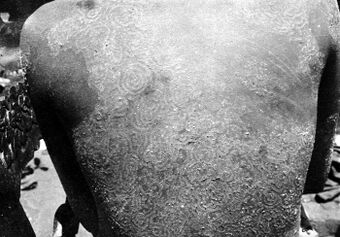Medicine:Tinea imbricata
| Tinea imbricata | |
|---|---|
| Other names | Tokelau[1] |
 | |
| Tinea imbricata | |
Tinea imbricata (also known in parts of Indonesia as “Kaskado”) is a superficial fungal infection of the skin limited to southwest Polynesia, Melanesia, Southeast Asia, India, and Central America.[1]:303[2] The skin lesions are often itchy, and mainly in the torso and limbs.[3] The name is derived from the Latin for "tiled" (imbricata) since the lesions are often lamellar.[4] It is often treated with griseofulvin or terbinafine.[4]
The risk of developing tinea imbricata is probably inherited as an autosomal recessive trait.[5][6]
Tinea imbricata is associated with Trichophyton concentricum.[4]
Tinea pseudoimbricata
The term "tinea pseudoimbricata" synonymous with "tinea indecisiva", was coined to describe a form of tinea mimicking the concentric rings of tinea imbricata, but is caused by local or systemic immunosuppression.[7] Since then, 3 cases of Trichophyton tonsurans have been associated with it,[8] as well as Trichophyton rubrum which can trigger mycosis fungoides.[9][10] Mixed infections with scabies have been described to produce tinea pseudoimbricata.[11][12]
As of 2015 in India, corticosteroid–antifungal–antibacterial combinations sold as over-the-counter drug have led to an increase in chronic, recurrent, difficult to treat fungal infections of the skin, including tinea pseudoimbricata.[13]
See also
- Skin lesion
- List of cutaneous conditions
References
- ↑ 1.0 1.1 James, William D. et al. (2006). Andrews' Diseases of the Skin: clinical Dermatology. Saunders Elsevier. ISBN 0-7216-2921-0.
- ↑ Rapini, Ronald P.; Bolognia, Jean L.; Jorizzo, Joseph L. (2007). Dermatology: 2-Volume Set. St. Louis: Mosby. pp. 285. ISBN 978-1-4160-2999-1.
- ↑ "Tinea Imbricata". The New England Journal of Medicine 375 (23): 2272. December 2016. doi:10.1056/nejmicm1516757. PMID 27959674.
- ↑ 4.0 4.1 4.2 "Tinea imbricata or Tokelau". International Journal of Dermatology 43 (7): 506–10. July 2004. doi:10.1111/j.1365-4632.2004.02171.x. PMID 15230889.
- ↑ "Autosomal recessive inheritance of susceptibility to tinea imbricata". Lancet 1 (8001): 13–5. January 1977. doi:10.1016/s0140-6736(77)91653-1. PMID 63655.
- ↑ "Genetic inheritance of susceptibility to tinea imbricata". Journal of Medical Genetics 17 (5): 342–8. October 1980. doi:10.1136/jmg.17.5.342. PMID 7218274.
- ↑ Lim S. P. R., Smith A. G. (2003). "Tinea corporis in a renal transplant recipient mimicking the concentric rings of tinea imbricata". Clinical and Experimental Dermatology 28 (3): 332–3. doi:10.1046/j.1365-2230.2003.01281.x. PMID 12780732.
- ↑ Ouchi T1, Nagao K, Hata Y, Otuka T, Inazumi T. Trichophyton tonsurans infection manifesting as multiple concentric annular erythemas. J Dermatol. 2005 Jul;32(7):565-8.
- ↑ Poonawalla T, Chen W, Duvic M (2006). "Mycosis fungoides with tinea pseudoimbricata owing to Trichophyton rubrum infection". J Cutan Med Surg 10 (1): 52–6. doi:10.1007/7140.2006.00007. PMID 17241575.
- ↑ Verma S, Hay RJ (2015). "Topical steroid-induced tinea pseudoimbricata: a striking form of tinea incognito". Int J Dermatol 54 (5): e192–3. doi:10.1111/ijd.12734. PMID 25601089.
- ↑ Poziomczyk CS, Köche B, Becker FL, Dornelles SI, Bonamigo RR. Tinea pseudoimbricata caused by M. gypseum associated to crusted scabies.An Bras Dermatol. 2010 Jul-Aug;85(4):558-9.[English, Portuguese]
- ↑ Verma S (2017). "Tinea pseudoimbricata". Indian J Dermatol Venereol Leprol 83 (3): 344–345. doi:10.4103/0378-6323.187686. PMID 27506504.
- ↑ Bishnoi Anuradha (2018). "Emergence of recalcitrant dermatophytosis in India". The Lancet Infectious Diseases 18 (3): 250–251. doi:10.1016/S1473-3099(18)30079-3. PMID 29485088.
External links
| Classification |
|---|
 |

